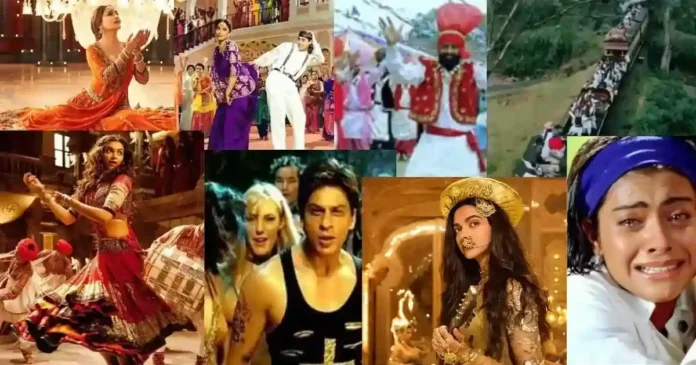Colors in Bollywood songs are the kaleidoscope of hues alongside the luxurious sets of a movie production. Colors in Bollywood songs are an integral part of setting up the mood or atmosphere of the song. They can denote emotions, symbolism, and even foreshadowing. In this blog, we go on a thrilling journey as we discover the different colors used in Bollywood songs and what they truly stand for.
We will point out specific colors in Bollywood songs that use each color well and how the colors really add to the effect and telling of these special musical pieces. Get ready for a visit in a world where colors in Bollywood songs, dance and melodies mix to create a fantastic symphony of feelings and visual beauty.
1. Red Colors in Bollywood Songs
The color red is captivating, intense, and oftentimes associated with strong emotions: love, passion, and danger. Most of the time in Bollywood songs, red is used to raise excitement and energy. For instance, in the song “Nagada Sang” from the movie “Goliyon ki Rasleela Ram-Leela.”, the view expressed with a bright red background and outfits builds an interesting atmosphere, passionate in its own way. The color red gives Bollywood songs more depth and symbolism, thereby adding emotion to them and leaving a lasting impression on viewers’ minds.
2. Green Colors in Bollywood Songs
A kaleidoscomatic world characterizes Bollywood songs, and the color green is given a significant place in it. In most cases, being associated with nature, growth, and new vigor, green gets used to reflect peace and serenity. Most importantly, the soothing presence in numbers like “Chaiyya Chaiyya” from the movie “Dil Se.” added to the list. This effect of running away and freedom is created by the green landscapes views in the song’s video footage, which places the viewer in a very peaceful and tranquil environment where he or she can be separated from the hustle and bustle of everyday routine.
3. Blue Colors in Bollywood Songs
Being a cool color, blue gives association with the vast sky and the calm sea and serene conditions. Blue has often been used symbolically in Bollywood songs to create a mood of sadness or longing. A good example is the song “Tujhe Yaad Na Meri Aayi” from the movie “Kabhi Kabhie,” where the lighting and clothes used are blue. The lighting and costumes add to the melancholy in the atmosphere of the song and suggest loss and a feeling of emotional yearning within the song.
4. Yellow Colors in Bollywood Songs
Yellow is such a bright, ebullient color, always related to joyful emotions: sunshine, cheer, and optimism. This color forms an important part in any Bollywood song to create the atmosphere of joy and celebration. For example, in the “Deewani Mastani” song in “Bajirao Mastani,” the very bright yellow, nice dresses, and beautiful decoration set the perfect festive environment, completing the atmosphere of joy and celebration. The color yellow in Bollywood songs dimensionally visualizes the music, engulfing the audience with a cinematic experience that is vivid and energetic.
5. Orange Colors in Bollywood Songs
Another color that has warm properties like red and is rich in energy holds very important meaning in a Bollywood song. It is majorly associated with fire, energy, and creativity; therefore, it is used to infuse charm and beauty. The song “Tabah Ho gai” from the movie “Kalank” revolves around this color. It creates the essential orange lighting and outfits that evoke play, fun, adventure, and subtle danger. This color adds more energy to the entire song video and leaves a great impact on the audience.
6. Purple Colors in Bollywood Songs
Purple is, in its way, captivating, enigmatic, and special in Bollywood songs. Purple is often associated with royalty, luxury, and mysticism; it evokes awe and wonder. In the song “Didi tera devar deewana” from the movie “Hum Apke Hain Kaun!,” purple lighting and costumes transport one to a place of pure enchantment and fantasy. The allure of the color strengthens the theme of the song by creating a visual spectacle through which the poetry and the melody have an even more strong impact on the viewer’s emotions.
7. Black Colors in Bollywood Songs
Black is a dark, mysterious color that reflects cultural and emotional connotations. In the case of Bollywood songs, black is often used as an effective cinematic and thematic tool for the depiction of tension, menace, and mystery. For instance, in the song “Kaal Dhamaal” from the movie “Kaal,” black clothes and lighting evoke an atmosphere of danger and anxiety. The black color gives an element of depth to the story and raises the effect of the song altogether.
8. White Colors in Bollywood Songs
White is a pure color that shines bright, representing something much more important in the Bollywood song. A color associated with innocence, peace, and new beginnings can be used to depict hope and positivity. White costumes and white doves are used in the song “Rang De Basanti” in the movie of the same name. These elements blend to evoke a patriotic setting and a positive vision for the betterment of a better tomorrow. White in Bollywood songs enhances its emotional resonance and strengthens the overall impact of narratives.
Colors in Bollywood songs prove to be a fundamental element in shaping the mood, atmosphere, and telling of Bollywood songs. From the igniting red color that triggers passion to the soothing green, speaking of nature’s calmness, each has a particular emotional weight and symbolic meaning. There’s a deeper appreciation for the arts and ingenuity involved in the making of these musical compositions once one understands what colors in Bollywood songs actually stand for.
You might also like: 10 Strange Traditions Around the World
Whether colors in Bollywood songs involves taking one to a different world or evoking an array of emotions by the visual impact, colors in Bollywood songs stand as testimonials to the colors’ transformation capabilities. The smart usage of colors not only enhances the aesthetic value of the song but also its emotional resonance, thereby making the songs timeless pieces that enthral audiences across age groups.


